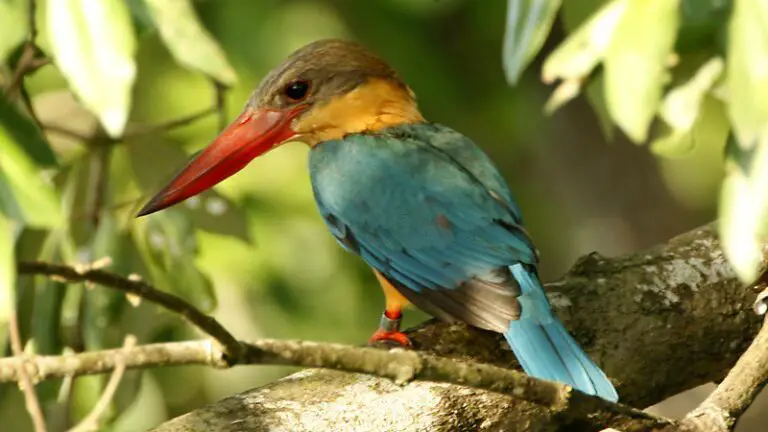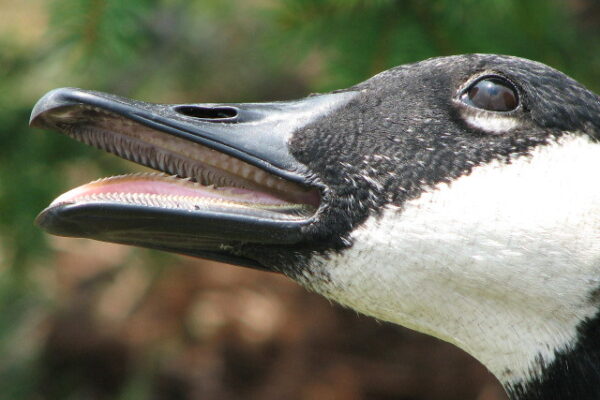Welcome to our exploration of the avian world, where we dive into the enchanting realm of blue birds with orange chest. Imagine birds with beautiful blue feathers and chests that shine in a warm and vibrant orange color. These charming creatures bring a burst of color and happiness to nature’s canvas. Join us on this journey as we discover these stunning birds, learn about where they live, and uncover their fascinating behaviors. Get ready to be amazed by the captivating combination of blue and orange, as we unravel the wonders of these unique avian species. So, let’s embark on this exciting adventure and discover the beauty of blue birds with orange chests!
List of Blue Birds with Orange Chest
- Eastern Bluebird
- Western Bluebird
- Barn Swallow
- Stork-billed Kingfisher
- Red-breasted Nuthatch
- Lazuli Bunting
- Belted Kingfisher
- Varied Thrush
- Blue Rock Thrush
- Tickell’s Blue Flycatcher
- Rainbow Lorikeet
- Hill Blue Flycatcher
- Taiwan Vivid Niltava
Eastern Bluebird
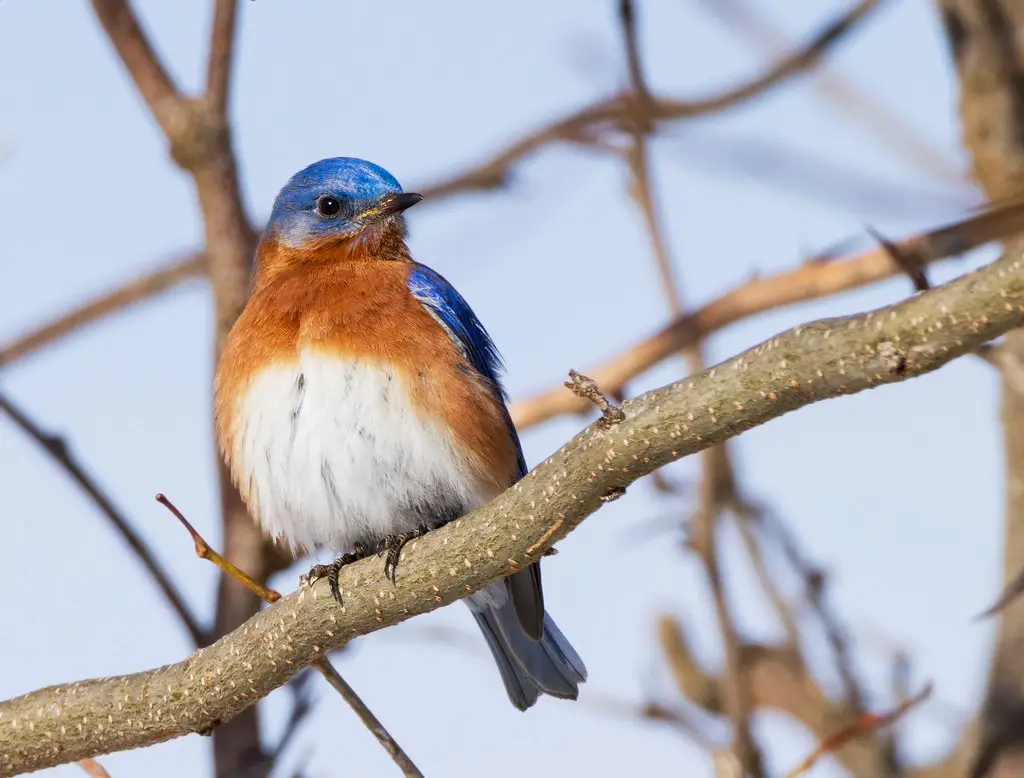
Image Source
- Scientific name: Sialia sialis
- Lifespan: 6 to 10 years
- Size: 6.3–8.3 in
- Native to: Eastern North America and south as far as Nicaragua
The Eastern Bluebird (Sialia sialis) is a small bird species native to North America. It is known for its vibrant blue plumage, which contrasts beautifully with its reddish-orange chest and white belly. The male Eastern Bluebird displays more intense colors, while the female has a slightly duller appearance. These birds are commonly found in open woodlands, meadows, and along forest edges. They feed primarily on insects, small fruits, and berries. Eastern Bluebirds are cavity nesters, often utilizing abandoned tree cavities or nest boxes for breeding. Their melodious song and stunning colors make them a favorite among birdwatchers and nature enthusiasts. They are also appreciated for their role in insect control and as indicators of healthy ecosystems.
Western Bluebird

- Scientific name: Sialia mexicana
- Lifespan: 6 to 10 years
- Size: 5.9 to 7.1 in
- Native to: North American
The Western Bluebird (Sialia mexicana) is a small bird species found in western parts of North America. It shares many similarities with the Eastern Bluebird, including its stunning blue plumage. However, the Western Bluebird is known for its distinctive orange-red chest, which adds a vibrant splash of color to its appearance. Both male and female Western Bluebirds exhibit this orange chest coloration. These birds inhabit open woodlands, grasslands, and shrublands, where they forage for insects, berries, and small fruits. Western Bluebirds are cavity nesters and often rely on natural tree cavities or nest boxes for breeding. Their beautiful song and striking coloration make them a delightful sight for birdwatchers and nature enthusiasts in their range. They also play a valuable role in ecosystem health by controlling insect populations.
Barn Swallow
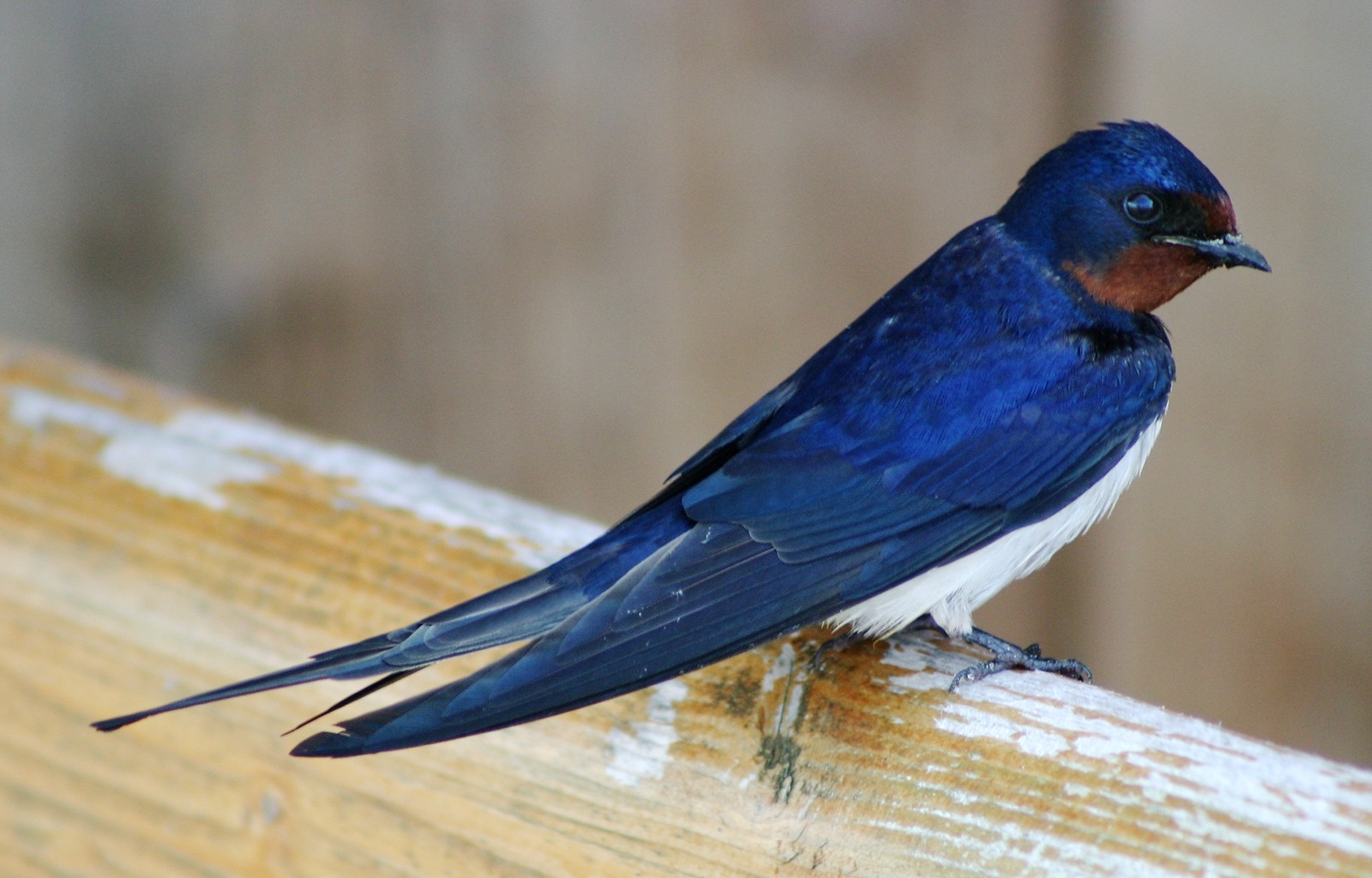
Image Source
- Scientific name: Hirundo rustica
- Lifespan: 4 years
- Size: 5.5 and 7 inches
- Native to: Europe, Asia, Africa, and the Americas
The Barn Swallow (Hirundo rustica) is a migratory bird species found throughout the world. With its deeply forked tail and long, pointed wings, it is easily recognized in flight. The upperparts of the Barn Swallow are a glossy blue-black, while its underparts are a rusty orange color, extending from the throat to the belly. These birds are known for their graceful aerial acrobatics as they swoop and dive in pursuit of flying insects, their primary food source. Barn Swallows construct cup-shaped nests made of mud, grass, and feathers, which are often attached to the eaves of buildings or other structures. They are highly adaptable and can be found in a variety of habitats, including open fields, meadows, and wetlands. The Barn Swallow’s distinctive appearance and agile flight make it a beloved species among bird enthusiasts.
Stork-billed Kingfisher

Image Source
- Scientific name: Pelargopsis capensis
- Lifespan: Up to 10 years
- Size: Approximately 35-38 centimeters (14-15 inches) in length
- Origin: Found in Southeast Asia, including countries like India, Myanmar, Thailand, Malaysia, and Indonesia.
The Stork-billed Kingfisher is a magnificent bird found in the tropical regions of Asia. It stands out with its vibrant plumage, featuring a rich blue upper body, a red bill, and a distinctive black mask around its eyes. With its striking appearance and large size, it is often considered one of the most impressive kingfisher species. Known for its extraordinary fishing skills, it perches patiently by water bodies and dives with remarkable speed and precision to catch its prey. Its loud and distinctive call can be heard echoing through the forests, adding to its allure. The Stork-billed Kingfisher is a true symbol of beauty and agility in the avian world.
Red-breasted Nuthatch

- Scientific name: Sitta canadensis
- Lifespan: 6 years.
- Size: 4.5 in
- Native to: North Americ
The Red-breasted Nuthatch (Sitta canadensis) is a small bird species known for its striking appearance and unique behaviors. It has a compact body with a short tail and a long, thin bill perfectly suited for probing into crevices in search of insects and seeds. As the name suggests, the Red-breasted Nuthatch displays a vibrant reddish-orange color on its breast, which contrasts with its bluish-gray upperparts. These birds are often found in coniferous forests, where they use their strong feet to climb up and down tree trunks and branches with agility. They have a distinctive “yank-yank” call that is frequently heard in their woodland habitats. Red-breasted Nuthatches are year-round residents in some areas, while in others, they may migrate south during the winter months. Their energetic and curious nature makes them a delight to observe for birdwatchers and nature lovers.
Lazuli Bunting

Image Source
- Scientific name: Passerina amoena
- Lifespan: Up to 6 years
- Size: Approximately 13 centimeters (5.1 inches) in length
- Origin: Native to western North America
The Lazuli Bunting (Passerina amoena) is a beautiful songbird found in North America. The male Lazuli Bunting is known for its vibrant plumage, which includes a bright blue head, back, and tail, and a rusty orange chest. The female has a more subtle appearance with brownish upperparts and a paler chest. These buntings inhabit open woodlands, brushy areas, and mountain meadows where they forage for seeds, berries, and insects. They are known for their melodious songs, which consist of a series of musical notes. During the breeding season, male Lazuli Buntings perform courtship displays by singing from prominent perches and fluttering their wings to attract females. Observing these colorful birds in their natural habitat is a treat for bird enthusiasts and nature lovers alike.
Varied Thrush (bird with orange chest and black wings)
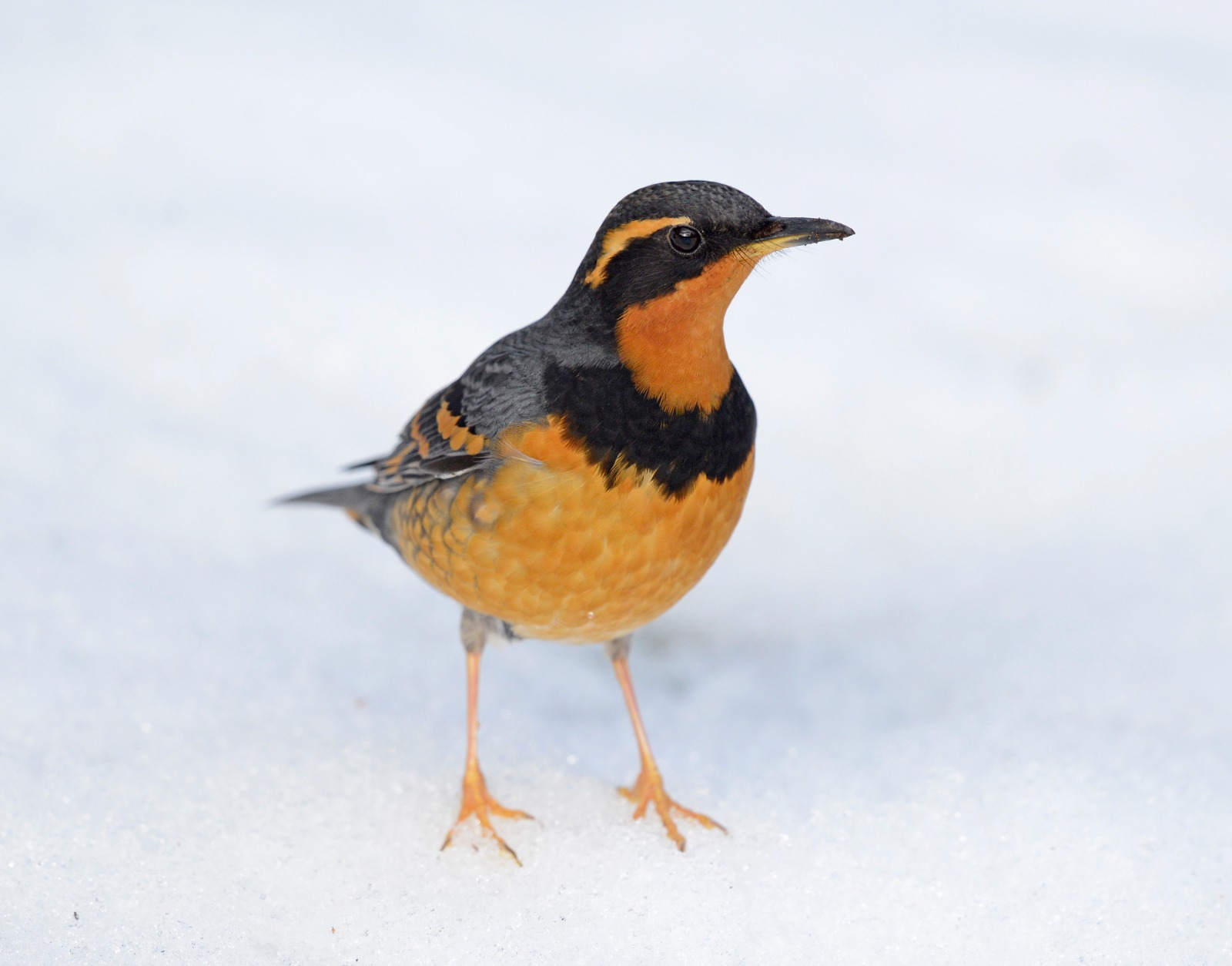
- Scientific name: Ixoreus naevius
- Lifespan: about 4 to 5 years
- Size: 7.9 to 10.2 in
- Native to: North America
The Varied Thrush (Ixoreus naevius) is a striking bird native to the western regions of North America. This medium-sized thrush is known for its distinctive plumage and hauntingly beautiful song. The male Varied Thrush features a deep orange breast and underparts, contrasting with a slate-blue head, back, and wings. The female has a more muted appearance with brownish-gray tones. These birds prefer forested areas, especially those with dense undergrowth and coniferous trees. They forage on the ground, searching for insects, berries, and seeds. The Varied Thrush is known for its melodic and flute-like song, often heard during the breeding season. Its ethereal vocalizations add a touch of enchantment to the woodland environment. The Varied Thrush is a favorite among birdwatchers, admired for its unique coloration and captivating music.
Belted Kingfisher (Blue Birds with Orange Chest)

Image Source
- Scientific name: Ardea alba
- Lifespan: 15 years
- Size: 3 feet
- Native to: Asia, Africa, the Americas, and southern Europe
Due to its greyish blue upperside, the Belted Kingfisher superficially resembles a Blue Jay.
On the other hand, the Belted Kingfisher is darker than a Jay and is more often seen near bodies of water.
Almost the whole top of an adult male Belted Kingfisher is teal blue, with the exception of a white collar that divides the cap from the body.
They also have a white belly and a grayish-gray chest band. The rufous orange flanks set females apart from males.
The Belted Kingfisher loves areas that are close to lakes and rivers, where it fishes by plunging into the water headfirst.
Although this bluebird only partially migrates, it may be observed all year long in Florida and other southern regions of its habitat.
Belted Kingfishers from the north go to warmer regions of the country throughout the winter.
Blue Rock Thrush
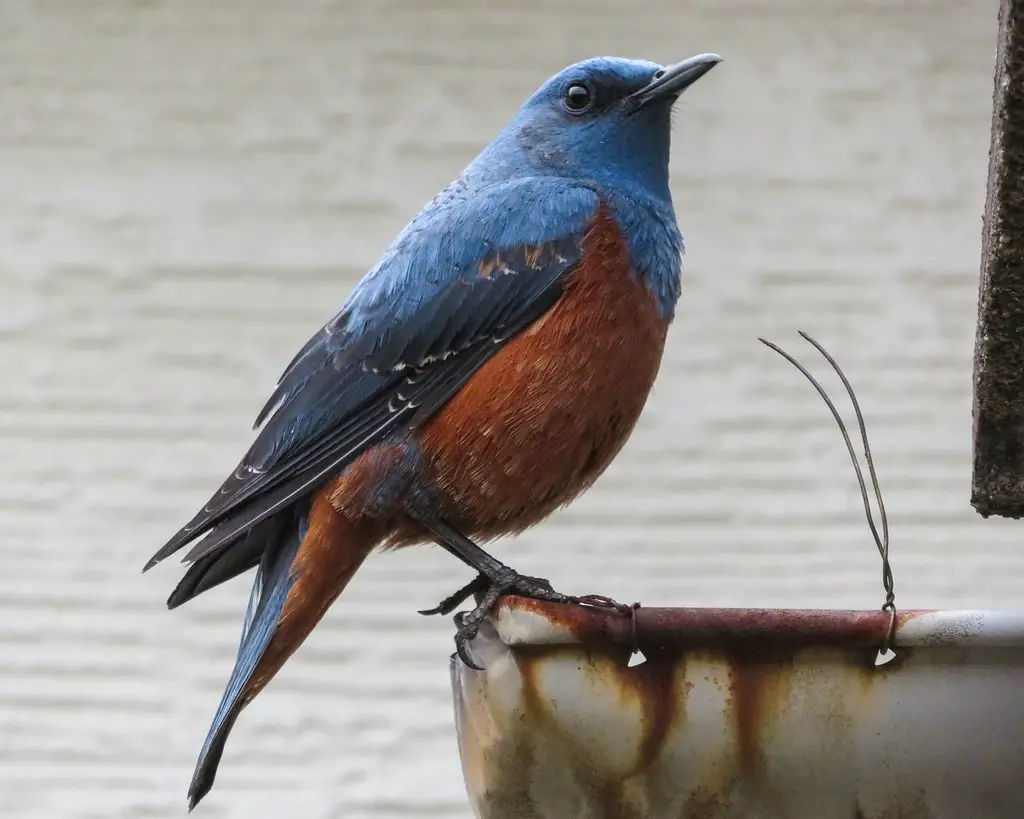
Image Source
Scientific name: Monticola solitarius
Lifespan: Up to 5 years
Size: Approximately 20-22 centimeters (8-9 inches) in length
Origin: Found in Europe, Asia, and North Africa, often seen in rocky habitats and cliffs
The Blue Rock Thrush is a captivating bird that can be found in various regions including Europe, Asia, and North Africa. The male Blue Rock Thrush is a striking sight with its vibrant blue plumage, contrasting against its grayish wings and tail. This bold coloration makes it easily distinguishable and adds a touch of vibrancy to its surroundings. The female, on the other hand, has a more subdued brownish coloration that helps her blend in with her environment. These thrushes are often found perched on rocky cliffs and buildings, where they display their beautiful plumage and sing melodious songs. With their agile flight and keen hunting skills, they feed on insects and small invertebrates. The Blue Rock Thrush is a delightful addition to any landscape, bringing both visual beauty and enchanting melodies.
Tickell’s Blue Flycatcher
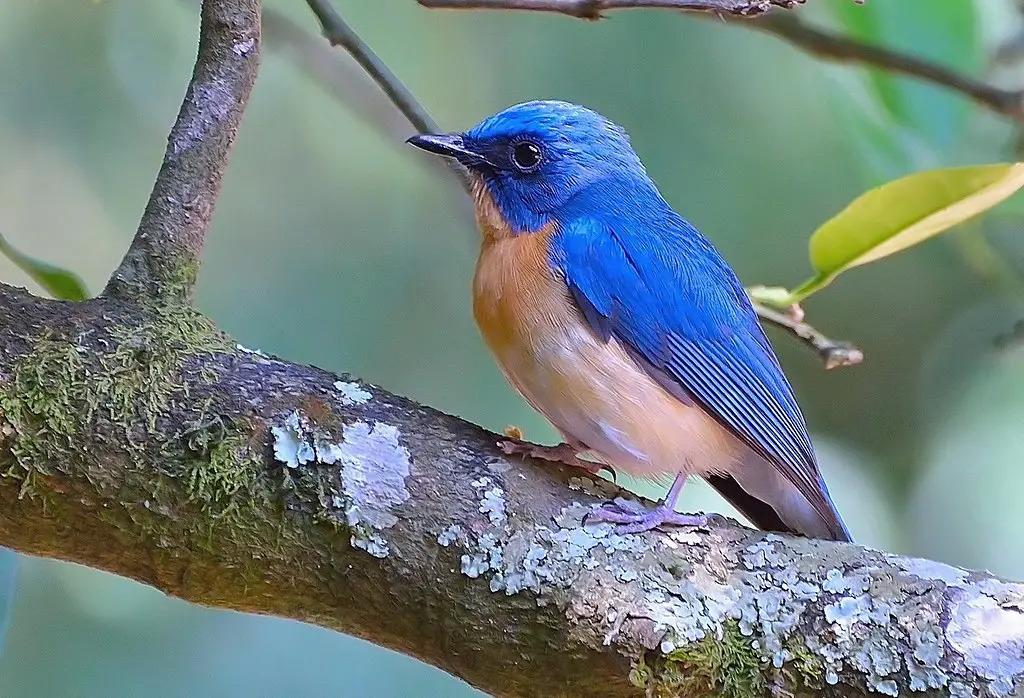
Image Source
Scientific name: Cyornis tickelliae
Lifespan: Up to 5 years
Size: Approximately 13-14 centimeters (5-6 inches) in length
Origin: Native to South Asia, often found in open forests, gardens, and shrublands
The Tickell’s Blue Flycatcher is a stunning bird known for its vibrant blue plumage and distinctive behavior. Native to South and Southeast Asia, this small passerine bird is a sight to behold. The male boasts a deep blue color on its upperparts and head, with a contrasting orange throat and breast, while the female displays a more subdued grayish-blue plumage. With its slender body and long tail, the Tickell’s Blue Flycatcher is an agile flyer, darting and hovering in search of insects to feed on. It is often found in wooded habitats, perched on branches or tree trunks, patiently waiting for its prey. Not only is it a skilled hunter, but it also possesses a melodious song that adds a delightful touch to the surrounding environment. The Tickell’s Blue Flycatcher is a true gem of the avian world, captivating observers with its beauty and graceful presence.
Rainbow Lorikeet

Image Source
- Scientific name: Trichoglossus moluccanus
- Lifespan: Up to 20 years
- Size: Approximately 30 centimeters (12 inches) in length
- Origin: Native to Australia, Indonesia, and Papua New Guinea, often found in forests, woodlands, and urban areas
The Rainbow Lorikeet is a stunning and vibrant bird native to the rainforests of Australia. Its name perfectly captures its striking appearance, as its plumage showcases a stunning array of colors. With a bright blue head, a deep green back, a vivid red chest, and a yellow abdomen, this bird is a true marvel of nature. The Rainbow Lorikeet is known for its playful and social nature, often seen in flocks or pairs, engaging in acrobatic flight, and vocalizing with high-pitched calls. It feeds primarily on nectar, pollen, fruits, and seeds, using its specialized brush-like tongue to extract nectar from flowers. This charismatic bird brings joy and beauty to its natural habitat and captivates observers with its vibrant feathers and lively personality. The Rainbow Lorikeet is truly a symbol of the colorful wonders of the avian world.
Hill Blue Flycatcher

Image Source
- Scientific name: Cyornis banyumas
- Lifespan: Up to 5 years
- Size: Approximately 13-14 centimeters (5-6 inches) in length
- Origin: Found in South Asia, often seen in hill forests, bamboo thickets, and gardens
The Hill Blue Flycatcher, also known as the Nilgiri Flycatcher, is a small bird found in the hill forests of the Western Ghats in India. It is known for its elegant appearance and melodious song. The male Hill Blue Flycatcher has a striking deep blue color on its upper parts, while the female has a more subdued brownish coloration. It has a slender body, a long tail, and a thin bill, perfectly suited for catching insects on the wing. This species is known for its agile flight and its ability to catch insects in mid-air with precision. It is often found perched on branches or vines, waiting patiently for its prey. The Hill Blue Flycatcher is a delightful bird to observe in its natural habitat, adding a touch of beauty and charm to the lush green forests it calls home.
Taiwan Vivid Niltava (Blue Birds with Orange Chest)

Image Source
- Scientific name: Niltava vivida
- Lifespan: Up to 5 years
- Size: Approximately 15 centimeters (6 inches) in length
- Origin: Native to Taiwan
The Taiwan Vivid Niltava, also known as the Taiwan Blue Thrush, is a stunning bird native to the forests of Taiwan. It is highly admired for its vibrant plumage and distinctive appearance. The male Taiwan Vivid Niltava displays a brilliant combination of blue and black feathers, with a contrasting white belly. Its eye-catching colors make it a standout species in the avian world. The female, on the other hand, has a more subdued appearance with brownish-gray feathers. This bird is known for its agile flight and its ability to forage for insects and berries among the trees. Its melodious song can often be heard echoing through the forest, adding to its allure. The Taiwan Vivid Niltava is a true gem of Taiwan’s avifauna, captivating birdwatchers, and nature enthusiasts with its beauty and grace.
Final Thoughts on Blue Birds with Orange Chest
Our exploration of blue birds with orange chests has been a delightful journey into the vibrant world of avian beauty. These stunning creatures, with their radiant blue feathers and captivating orange chests, have left us in awe of nature’s artistic palette. Their presence brings joy and adds a splash of color to the natural landscape. From the majestic Stork-billed Kingfisher with its brilliant blue plumage and orange-tinged chest to the charming Eastern Bluebird with its gentle blue hues and vibrant orange breast, each species has its unique allure. These birds serve as a reminder of the incredible diversity and beauty found in the avian realm. As we conclude our adventure, let us cherish and protect these enchanting creatures, ensuring their habitats remain intact for future generations to appreciate the mesmerizing beauty of blue birds with orange chest.
FAQs on Blue Birds with Orange Chest
Why do these birds have blue feathers and orange chests?
The blue feathers of these birds are a result of structural coloration, where the feathers scatter and reflect light to create the blue appearance. The orange coloration on their chests is often due to pigments called carotenoids, which are acquired from their diet.
Where can these birds be found?
Blue birds with orange chests can be found in various habitats across North America, including woodlands, forests, and open fields. Their specific ranges can vary depending on the species and their migration patterns.
What is the purpose of the orange chest in these birds?
The orange chest in these birds can serve multiple purposes. It can play a role in attracting mates during the breeding season and may also act as a visual signal to other birds of their species.
Are all blue birds with orange chests closely related?
Not necessarily. While some blue birds with orange chests may belong to the same family or genus, others may have different taxonomic classifications. Their shared coloration may be a result of convergent evolution or similar ecological pressures.
Can the color of their feathers or chests change?
The color of their feathers and chests generally remains consistent throughout their lives. However, factors like diet quality and overall health can affect the intensity or brightness of the coloration.

